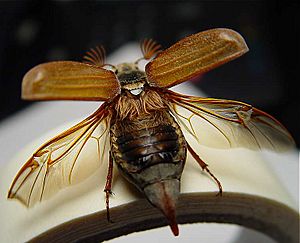Elytra facts for kids
Elytra are special, tough front wings found on beetles and some other insects called true bugs (Heteroptera). Think of them like a strong shield that protects the delicate flying wings underneath! For most true bugs, these front wings are called hemelytra. This is because only the part closest to the body is hard, while the tip is soft and see-through.
How Elytra Help Beetles
The main job of the elytra is to protect the beetle's soft hind wings. These hind wings are the ones beetles actually use for flying. When a beetle wants to fly, it first opens its tough elytra. Then, it stretches out its thin hind wings. The beetle flies while holding its elytra open, like little doors.
However, some beetles, like those in the Scarabaeidae family (which includes dung beetles) and Buprestidae family (known as jewel beetles), can fly with their elytra closed. This is pretty unusual!
Flightless Beetles
Not all beetles can fly. In some groups, the elytra are actually stuck together, or "fused." This means the beetle cannot open them to use its hind wings, making the insect unable to fly. A good example of this are some types of ground beetles (from the Carabidae family). Even though they have elytra, they walk or run instead of flying.
Images for kids
See also
 In Spanish: Élitro para niños
In Spanish: Élitro para niños





